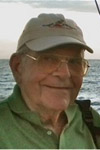In Memoriam: Frederick Mills
 |
| Frederick Mills |
Frederick Mills, a physicist who worked at Fermilab when the lab was beginning to build the Tevatron, passed away in Tucson, Ariz,. on June 21. A pioneer in the area of proton synchrotron technology and a fellow of the American Physical Society, Fred worked at Fermilab from 1973 until 1992. His 19 years of work at the laboratory are to this day highly regarded in the field of accelerator physics.
Fred was one of a small group of innovators who proposed to use Fermilab's Main Ring accelerator for very-high-energy proton-antiproton collisions. The Main Ring had accelerated protons toward a fixed target in earlier experiments, but Fred and others saw that, provided a suitable antiproton source could be developed, the Main Ring could be used to collide two moving beams, increasing the collisions' energies.
However, because the Tevatron offered greater long-term opportunities for colliding beams, Fermilab initiated an R&D program on antiproton collection and electron cooling with the goal of preparing the Tevatron for proton-antiproton collisions, even though the Tevatron was stretching its resources to the limit. Over the next several years, Fred, Jim Griffin, Peter McIntyre and Don Young led the team that designed and built a small 200-MeV proton storage ring and a 110-keV electron cooling system. Fred helped bring about a collaboration between Fermilab and the Budker Institute in Novosibirsk, which had developed electron cooling and lithium lenses, and helped Fermilab incorporate these techniques into its plans. Argonne and Lawrence Berkeley laboratories built beam diagnostics and prototype multi-gigahertz stochastic cooling systems for the cooling ring. Cooling experiments in the 200-MeV ring provided this collaboration with their first opportunity to test prototypes of these innovative cooling systems.
In 1982 Fermilab completed the design of the Tevatron I antiproton source, which used multi-gigahertz stochastic cooling systems. Fred led the design and measurements efforts for the magnets for the Debuncher, Accumulator and beam transport systems, and he also led the design of the vacuum systems and beam position detectors for the cooling rings. Thanks to the Fred's work and the innovative work of that team, the antiproton source was completed in 1987 and integrated into the Fermilab accelerator complex. Tevatron collider operations began at 1.8 TeV—the highest energy any collider had achieved. The Tevatron defined the Energy Frontier for the next 20 years.
In addition to his work on Fermilab accelerators, Fred contributed to the design of a facility for cancer treatment. He, along with Phil Livdahl, Lee Teng, Don Young and others, designed a synchrotron for proton therapy at the Loma Linda University Medical Center. It was built and commissioned at Fermilab and then shipped to Loma Linda, California, where it was
reassembled, recommissioned and put into service. It was the first proton therapy machine that was designed specifically to operate within a hospital setting. Loma Linda began treating patients in 1990, and it continues to treat patients to this day.
Fred continued to explore the possibility of using electron cooling for particle physics and nuclear physics, even after leaving Fermilab in 1992. He used a Pelletron at the National Electrostatics Corporation (NEC) in Wisconsin to test the feasibility of a relativistic electron cooling system, and these tests showed considerable promise.
Fred's influence at Fermilab extended well beyond his retirement. In 1996, Fermilab expanded the scope of the Main Injector to include the Recycler to provide a third stage of antiproton cooling to increase their stacking rate and stack size. While the Recycler was designed to use stochastic cooling, scientists and engineers recognized the possibility for adding a relativistic electron cooling system. Fred's vision and experience at NEC became the starting point for the successful development of an electron cooling system based on a 4.5-MeV Pelletron. When it was put into service in the Recycler in 2005, it was the world's first—and, to this date, only—relativistic electron cooling system, and it enabled a substantial increase in the Tevatron luminosity.
Fred was invaluable not only to Fermilab, but to the field of high-energy physics. His extensive knowledge of accelerator technologies was very important to the success of these Fermilab projects. His passing brings us great sadness, but is also an opportunity to remember the many significant ways he elevated the accelerator technology that not only bring us closer to understanding our world, but has improved our well-being.
To learn more about his contributions and his life in this The New York Times article.
—John Peoples, Sergei Nagaitsev and Steve Holmes
|